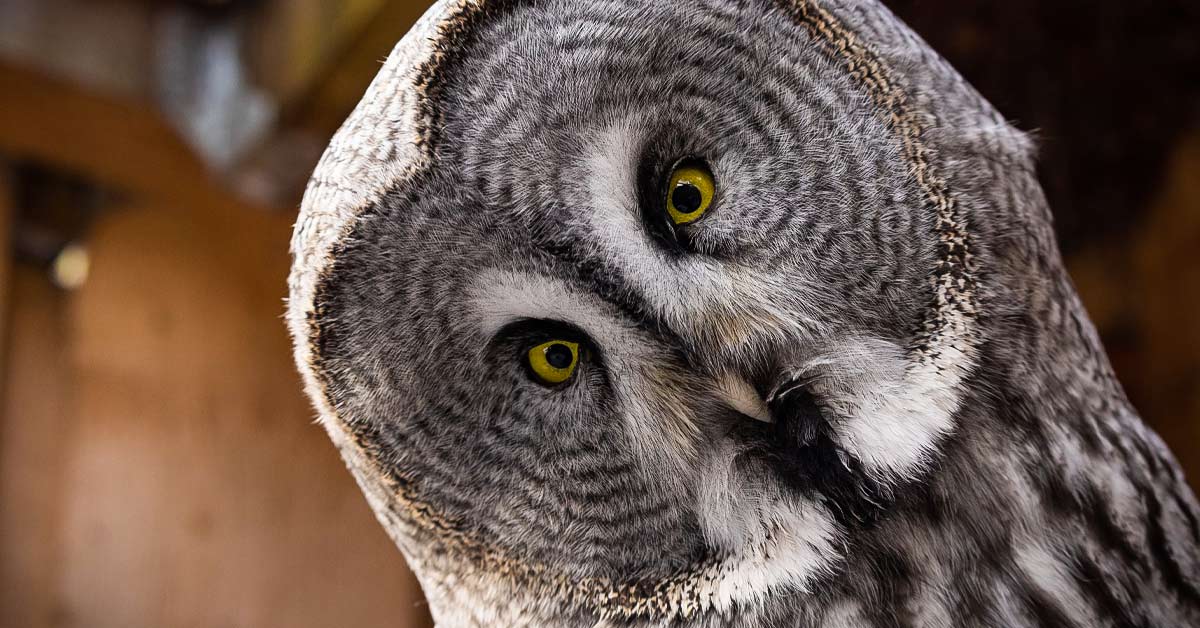Did you know there are 20 species of owls found in the United States? However, there are only handful of owls in Utah that you can see in the state year-round.
If you’re curious about what kinds of owls in Utah you’re bound to see if you spend time bird-watching, read on to find out.
7 Owls in Utah
Before we tackle the different types of owls in Utah, I’m gonna answer some FAQs first.
- What’s the most common owl in Utah? That would be the Great Horned Owl (which I talked about in my Kentucky owls post).
- What’s the biggest owl in Utah? That would be the Great Gray Owl. Aren’t they so aptly named? (Read below for more info about the Great Gray Owl)
- What’s the smallest owl in Utah? The Northern Saw-whet Owl is one of the smallest owls not only in Utah but in the entire country.
So now that I got that covered, here are the owls in Utah that are around the area year-round:
1. Great Gray Owl or Great Grey Owl (Strix nebulosa)
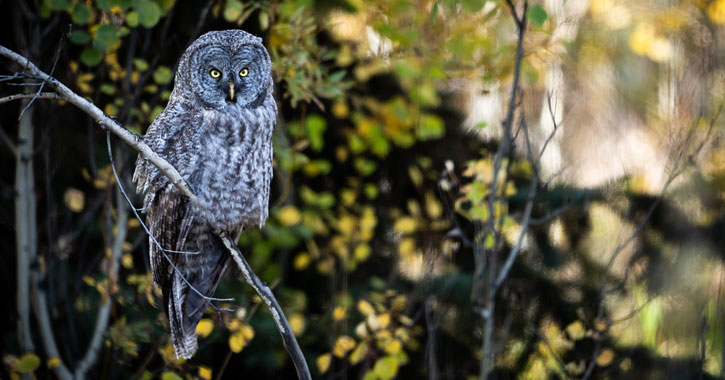
One of the most intimidating owls in the country, the Great Gray/Grey Owls that are found in Utah are the non-breeding ones. This owl species breeds in the north, in both the Eastern and Western Hemispheres.
Appearance: What do Great Gray Owls look like?
- Length: 60 to 85 cm
- Weight: 25 to 60 ounces
- Wingspan: 152 cm
Great Grey Owls have a silver-grayish pattern with a gorgeous pattern of brown, white, and gray streaks all over. They also have a distinct “bow tie” making Great Gray Owls look like an old gentleman.
As you can see from the picture below, the eyes of Great Gray Owls are piercing bright yellow with contrasting gray and brown circles of the facial disk. The dramatic arc in the center of the eyes forms a deep “X” that you can’t miss.
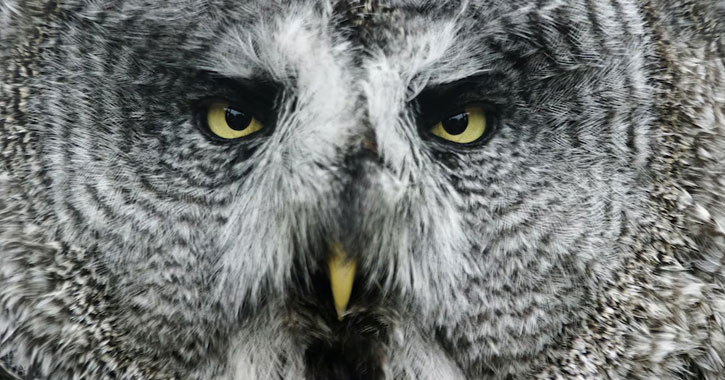
Sound: What do Great Gray Owls sound like?
The Great Grey Owl’s hoot is soft and low-pitched that sounds like a slow-mo whooo-hooot, but repeated after around 20 seconds.
Characteristics: What makes Great Gray Owls special?
Great gray owls hunt chipmunks, voles, and other small mammals in fir or pine forests. They’re not like other owls who build their nests – these Great Gray owls prefer to recycle and reuse old nests they stumble upon.
These owls aren’t just intimidating physically – they can really fight thanks to their powerful talons. Plus, Great Gray owls are known to have exceptional hearing that they only hunt by sound.
Where to find Great Gray Owls in Utah
The Great Gray Owl was first spotted in the Mountain Green town in 1989. Since then, this owl isn’t as common on others on this list, but they’re not rare either. You can find Great Gray Owls in the northeastern part of Utah.
2. Western Screech Owl (Megascops kennicottii)
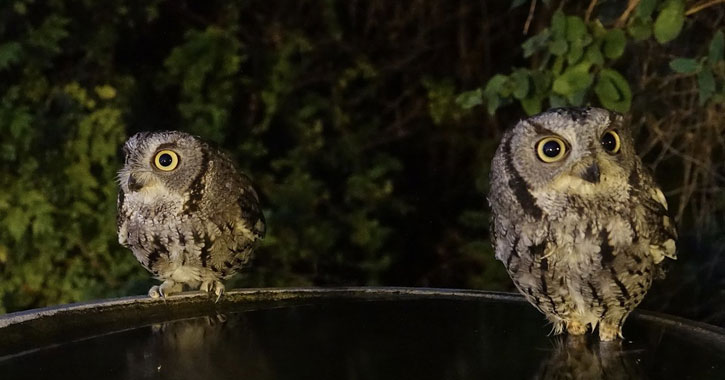
Western Screen Owls are common Utah owls. If you go to forest state parks, they’re a usual sight at high trees. They sometimes even visit residential areas.
Appearance: What do Western Screech Owls look like?
- Length: 19 to 27 cm
- Weight: 3 to 8 ounces
- Wingspan: About 55 cm
The Western Screech Owl is a short and stocky owl with short tails, rounded feet, long wings and plumage that ranges from grays to browns with tinges of red in color.
This particular owl features ear tufts that look like small horns. Western Screech Owls have excellent hearing and eyesight thanks to their binocular eyes and asymmetrically-positioned ears.
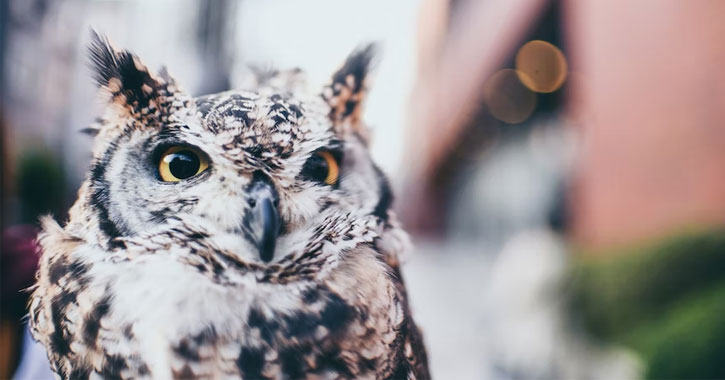
Sound: What do Western Screech Owls sound like?
The hoots of Western Screech Owl aren’t really a screech. People describe it as more of an accelerating trill, a series of hoots that speed up near the end.
Characteristics: What makes Western Screech Owls special?
A Western Screech Owl’s eyes cannot move in their sockets, so the owl has to turn its head completely (up to 270 degrees) to see what’s going on around him/her.
The colors of the Western Screech Owl’s feathers are good for camouflage. They hunt for birds, large insects and small mammals, depending on which area they live.
Where to find Western Screech Owls in Utah
Western Screen Owls breed in Utah’s mountain riparian and lowland riparian habitats.
They live in woodlands and forests, but you can also find these nocturnal birds at the Hogle Zoo.
3. Northern Pygmy-Owl (Glaucidium Gnoma)
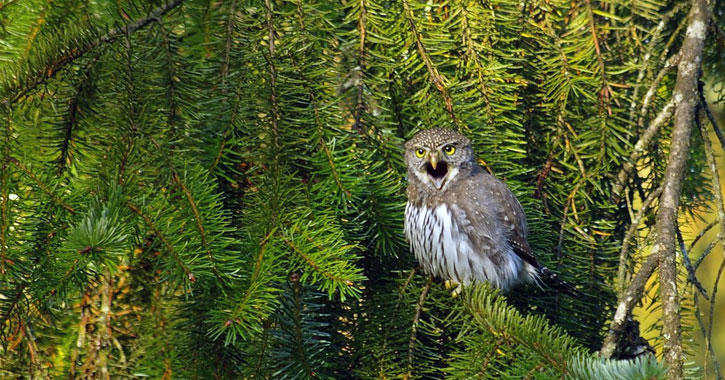
The Northern Pygmy owl is smaller than a soda can, but they’re exceptional hunters with unique non-owl characteristics.
Appearance: What do Northern Pygmy Owls look like?
- Length: 15 to 18 cm
- Weight: 2 to 3 ounces
- Wingspan: 30 cm
Northern Pygmy Owls are very small owls (adult size grows anywhere below 7 inches and 2 ounces).
Their plumage varies from brown to gray, but the chests of Northern Pygmy owls usually have white and dark-brown streaks and their heads with snow-like white spots.
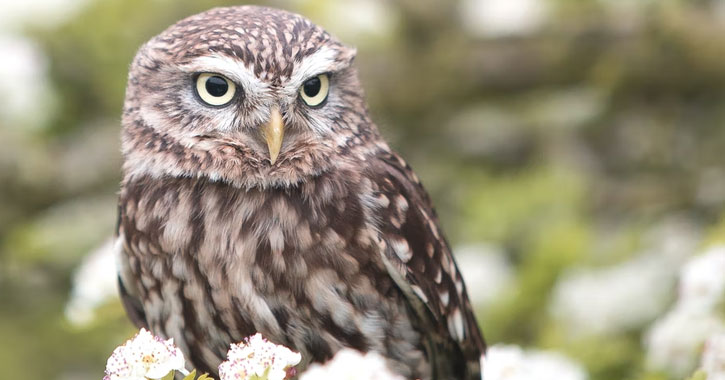
Sound: What do Northern Pygmy Owls sound like?
Northern Pygmy Owls make a high-pitched, hollow toot with rapid (about 2-second) successions, which could go on for hours.
Characteristics: What makes Northern Pygmy Owls special?
These adorably small owls are different from other nocturnal owls who develop excellent hearing because they had to hunt in the dark.
Instead, Northern Pygmy Owls rely more on their eyesight since they can hunt and be active during daylight.
Another interesting characteristic of Northern Pygmy owls? They don’t fly quietly like other owls. In fact, these owls have been known to have a buzzing sound in flight.
Also, they might be small, but their “eyespot” (a feature that looks like eyes on the back of their heads) fool predators all the time.
Where to find Northern Pygmy Owls in Utah
In Utah, you can find Northern Pygmy Owls in open woodlands, tropical moist forests, wetlands, dense forests, and other areas near streams, swamps, or meadows.
4. Boreal Owls (Aegolius funereus)
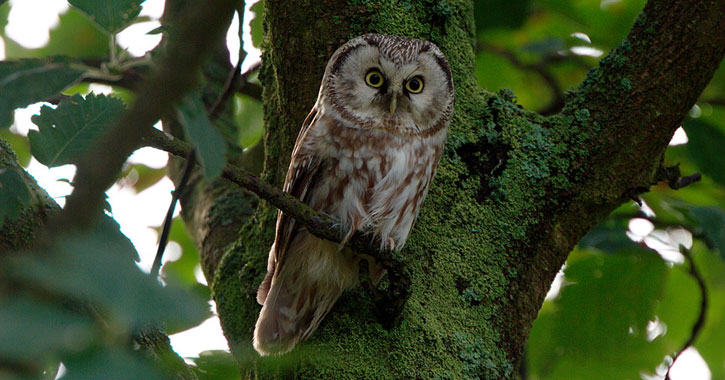
Boreal Owls are very rarely seen for several reasons.
They’re small, highly nocturnal, and prefer to inhabit inaccessible areas.
Appearance: What do Boreal Owls look like?
- Length: 20 to 23 cm
- Weight: 3 to 8 ounces
- Wingspan: About 55 cm
Boreal owls have square-shaped large heads with stocky bodies and short tails. They have yellow beady eyes and matching yellow-tinged beaks.
The plumage is brown neck up, but the chest and shoulders have white and rust-colored streaks.
Many describe a Boreal owl as an “owl with eyebrow” because of the distinctive white streaks above the eyes forming a V-shaped “brow.”
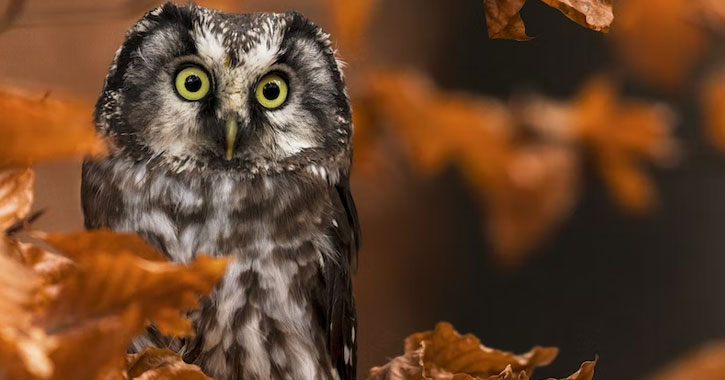
Sound: What do Boreal Owls sound like?
Boreal owls are quiet owls and are famous for not calling often. However, when they do make noises in the late winter to spring, their hoots are quick and at nighttime.
Characteristics: What makes Boreal Owls special?
Boreal owls are as small as robins but can hunt small mammals and birds thanks to their strong talons.
Where to find Boreal Owls in Utah
As their name suggests, Boreal owls live in the boreal forest of spruce, birch and balsam fir trees that are found across northern North America and Eurasia.
In Utah, Boreal owls have been spotted in the Uinta Mountains, Franklin Basin, the Beaver Mountain Ski Area, and other areas east of Salt Lake City.
5. Flammulated Owl (Psiloscops flammeolus)
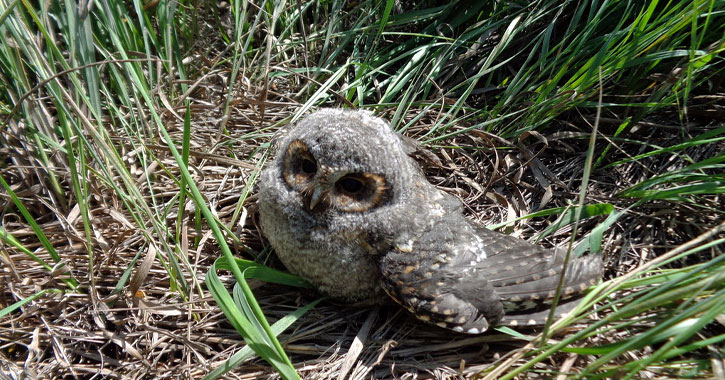
The flammulated owl is one of the smallest North American owls with a unique pair of all-black eyes (rare amongst the many two-colored owl eyes).
Appearance: What do Flammulated Owls look like?
- Length: 15 cm
- Weight: 1.5 to 3 ounces
- Wingspan: 36 cm
Flammulated owls look like screech owls, but their ear tufts are shorter (sometimes not even visible) and their overall size is smaller. These owls also have reddish-gray plumage, which allows them to camouflage in trees quite nicely.
Flammulated owls also have dark bead-like round eyes and a flame-like marking on their face.
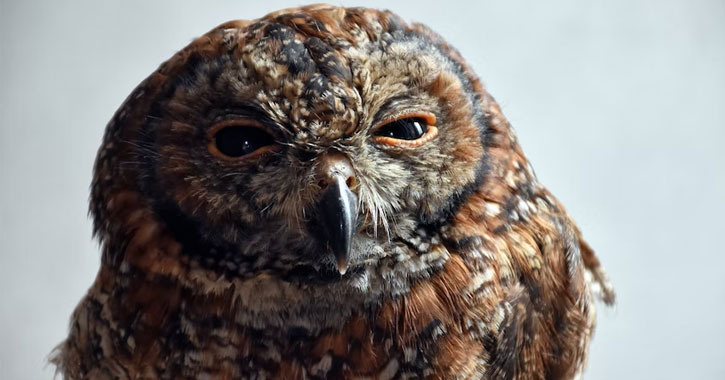
Sound: What do Flammulated Owls sound like?
Flammulated Owls have a low-pitched, dramatically deep repetitive hoot that predators are fooled by thinking the owls are larger than they actually are.
Characteristics: What makes Flammulated Owls special?
This reddish brown, small owl is highly migratory.
It winters in Mexico and Central America, which makes it harder to find once the Flammulated Owls do arrive in Utah. The owl’s ability to camouflage also makes it double-hard to spot these birds.
Where to find Flammulated Owls in Utah
Flammulated Owls love staying in mountainous pine forests with large trees.
In Utah, you can see these birds in person in the mountains just outside of Salt Lake City, usually in the Zion National Forest, the Tushar Mountains, and the Wasatch range.
6. Mexican Spotted Owl (Strix occidentalis lucida)
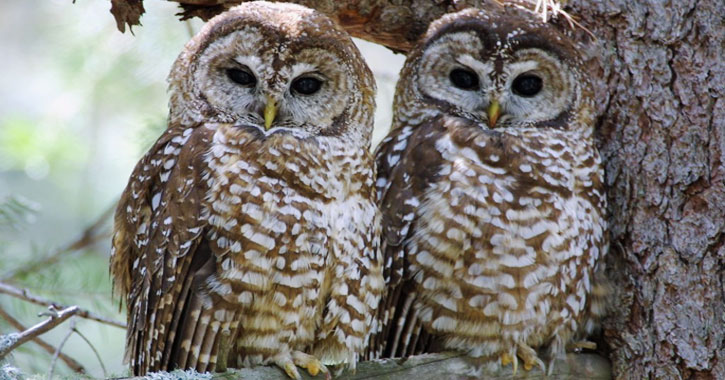
The Mexican spotted owl ranks as one of the largest owls in North America.
It is listed as “threatened” by the U.S. government.
Appearance: What do Mexican Spotted Owls look like?
- Length: 40 to 50 cm
- Weight: 18 to 25 ounces
- Wingspan: 107 to 114 cm
The Mexican spotted owl has a pale face on its rounded head and no ear tufts.
They’re one of the larger species of owls in Utah and they come in dark brown and gray plumage.
Compared to other spotted owl species, the Mexican variety has larger and lighter-colored white spots on the back, head, and bellies. Their brown tails also have a streak of white band markings.
Mexican Spotted Owls also have pitch-black eyes.
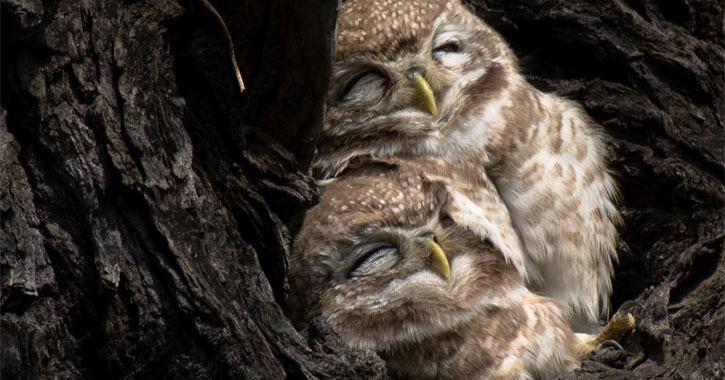
Sound: What do Mexican Spotted Owls sound like?
The hoots of male Mexican spotted owls are deep, while females are higher-pitched. Mated pairs make whistling high-pitched sounds to keep connected.
Characteristics: What makes Mexican Spotted Owls special?
Even if they’re large owl species, Mexican Spotted Owls are hard to find. They hunt mostly at night, preying on bats, smaller birds, insects, rabbits, or gophers.
Outside of the breeding season, Mexican spotted owls are generally solitary. They are monogamous owls, sticking to long-term bonds with their mates.
Where to find Mexican Spotted Owls in Utah
If you watched the video above, you’ll discover that you can find Mexican Spotted Owls in Zion National Park, which offers a conducive habitat for these owls.
They remain in southern and southeastern Utah year-round, nesting and roosting in narrow canyons.
7. Snowy Owl (Bubo scandiacus)
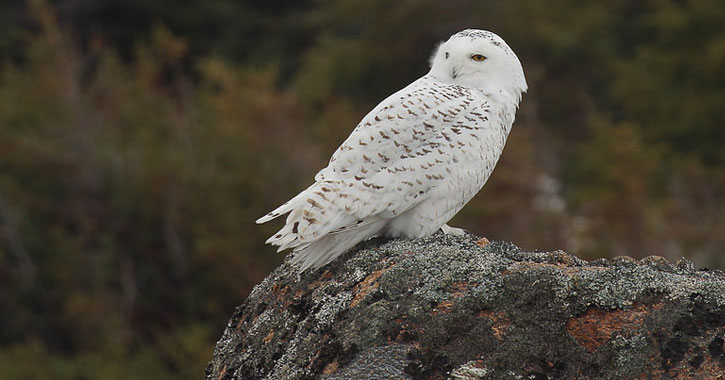
The Snowy Owl is listed as an “accidental” species in Utah.
They’re rare but not extinct, so birding officials advise reporting any sighting.
Appearance: What do Snowy Owls look like?
- Length: 55 to 70 cm
- Weight: 55 to 105 ounces
- Wingspan: 50 to 60 cm
Snowy owls are angelic-looking birds with males showcasing all-white plumage and females with distinctive black streaks.
Regardless of gender, Snowy owls have yellow and black eyes, a dark beak, and a fluffy white face and feet.
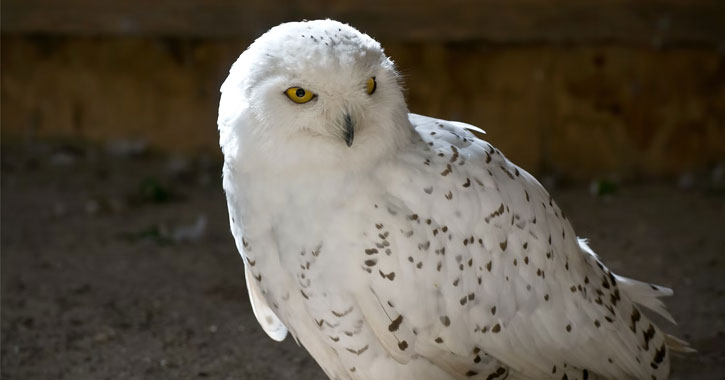
Sound: What do Snowy Owls sound like?
The calls of Snowy owls are varied, but their most popular sound is a barking alarm call and a deep repeating gahw.
Characteristics: What makes Snowy Owls special?
Snowy owls are opportunistic hunters and not-picky eaters.
They are also carnivores.
And because these owls are quite large, they can easily feed on a wide variety of small mammals from lemmings and meadow voles to deer mice. They can swallow small prey whole.
Where to find Snowy Owls in Utah
Snowy owls prefer areas with meadows, marshes, agricultural fields, and other areas with rising elevation.
These gorgeous owls have been spotted in Bear Lake Valley, Cache Valley, on the causeway to Antelope Island, and other parts of northern Utah.
How Many Owls in Utah Have You Seen in Person?
If you plan on bird-watching in Utah, your best bet is to visit parks like Zion and ask for assistance with where to look. Most rangers are familiar with the owls living within their parks.
For birders who love to “wing it,” you can always rely on the call/song recordings, and photos for identification.
Just be careful not to disturb these creatures (especially threatened species like the Mexican spotted owls) as they might see you as a threat.
